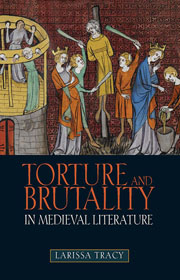Book contents
- Frontmatter
- Contents
- Acknowledgements
- Abbreviations
- Introduction
- 1 Rending the Flesh: The Orthodoxy of Torture in Hagiography
- 2 Resisting the Rod: Torture and the Anxieties of Continental Identity
- 3 The Matter of the North: Icelandic Sagas and Cultural Antonomy
- 4 The Matter of Britain: Defining English Identity in Opposition to Torture
- 5 Laughing at Pain: The Comic Uses of Torture and Brutality
- 6 Medieval Torture and Early-Modern Identity
- Conclusion
- Select Bibliography
- Index
1 - Rending the Flesh: The Orthodoxy of Torture in Hagiography
Published online by Cambridge University Press: 05 September 2013
- Frontmatter
- Contents
- Acknowledgements
- Abbreviations
- Introduction
- 1 Rending the Flesh: The Orthodoxy of Torture in Hagiography
- 2 Resisting the Rod: Torture and the Anxieties of Continental Identity
- 3 The Matter of the North: Icelandic Sagas and Cultural Antonomy
- 4 The Matter of Britain: Defining English Identity in Opposition to Torture
- 5 Laughing at Pain: The Comic Uses of Torture and Brutality
- 6 Medieval Torture and Early-Modern Identity
- Conclusion
- Select Bibliography
- Index
Summary
‘It revolts me to have recourse to measures the church has always criticized when they are employed by the secular arm. But there is a law that governs and directs even my personal feelings. Ask the abbot to provide a place where the instruments of torture can be installed.’
Bernard Gui, The Name of the Rose, Umberto Eco (pp. 465–6)One of the enduring literary motifs of medieval hagiography is the array of vicious tortures to which saints, particularly virgin martyrs, are subjected in their steadfast defiance of pagan authorities. In Christian terms, the tortured body of the saint is, for the hagiographer and his audience, ‘a testimony to the power of God and the Church’ and the failure of these horrific tortures ‘functions as proof that steadfast spiritual faith can overcome physical suffering’. The monstrous actions of the tormentors are juxtaposed against the righteous stance of the saints; and in their resistance to torture, which rarely has a permanent effect on them, their sanctity is assured. Historically, medieval torture is most commonly associated with judicial proceedings against heretics during the period of inquisitorial courts from the late twelfth century onwards, notably the Albigensian Crusade (1209–1229) through to the inception of the notorious Spanish Inquisition in 1478. The form and frequency of torture in hagiography may have provided models of resistance and defiance for heterodox sects who saw themselves and their suffering at the hands of Church authorities reflected in the stories of early Christian saints, even though they rejected the adoration of those saints.
- Type
- Chapter
- Information
- Torture and Brutality in Medieval LiteratureNegotiations of National Identity, pp. 31 - 69Publisher: Boydell & BrewerPrint publication year: 2012



